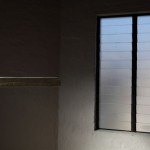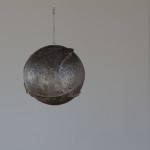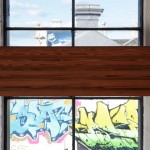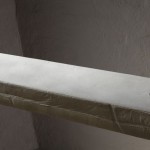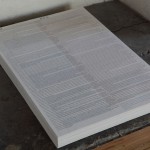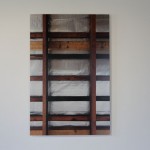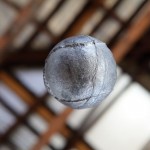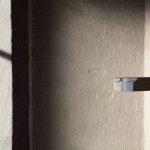Conical 19 May – 9 June 2012
In the text object accompanying this exhibition, Brett Jones offers three interwoven texts, three voices: the original proposal, elaborations on the ideas in the proposal, and thirdly, reflections on aspects of the other two. In the spirit of textuality, he offers the text publication as an object of exhibition, an object that the reader may or may not chose to read. He has produced a publication that provides some theoretical arguments that circulate amongst the objects (texts) in the space. In a similar way to the air flowing through the space, one can ask how to determine whether the air currents have originated on the outside or the inside of the space. This seems to be his point: that the Text has no point of origin and that it is not possible to determine whether it is inside or outside the objects to which it may write. He claims that if the viewer observes and listens the objects presented may be interpreted in a multiplicity of ways, and that the space is completely implicated in these readings. In this way the objects, highlight the textual production of space and context; the space is integral to the signifiers that are suspended. Yet, in the published text he laments the problems of opening up readings as soon as the word appears in print. Indeed, I would suggest that you don’t read this publication, rather it’s materiality as a pile of newsprint sitting on the floor provides sufficient opportunities for reading and re-writing. It’s all been said before.
CHI PY’S List
Somewhat tissue paper 2012
Rather polyurethane resin 2012
Seemingly newsprint 2012
Like lead 2011
Henceforth wood 2012
While Sound 2012
Thereafter C-Type photograph, aluminium 2012
CHI PY’S notes on materiality
- Somewhat (2012) similar to a washed up piece of plastic (possibly high density polypropylene), but not similar at all; casting as a paradox of indexicality: where is the referent? Is it the found object itself or is it the rematerialised object in its own right? Or is it the photograph of this rematerialized object or the words to which I write it (these very words)? The signs no longer directly refer to a particular referent. Though there are ghostly remnants of prior sign systems, transposition has allowed this rematerialized object to be something quite different. Acid free Japanese Tengucho 8gsm tissue paper and starch paste (looks like plastic or styrofoam). Four-part mould with silicon liner. Robert Gober cast a piece of black polystyrene foam (also found on a beach) in bronze and painted it white. Though somewhat lighter than injection moulded plastic, it is white like Gober’s bronze, but suspended in space floating, a fragment (Gober’s sits on the floor). There is also the corner relation with the bagged white brick wall. A particular photograph depicts the object floating with its texture juxtaposed to that of the wall; a perplexity of weight and light, form and surface.
- Rather (2012) unlike tissue paper, instead clear polyurethane. Frosted with the texture of the mould: two-part, platinum silicon liner. Floating in front of the frosted glass louvers releasing light in the afternoon; 2.00 – 4.00pm optimum. Lines up with the central pane of the left east-facing window. A fragment sheared off, displaced, to be cast as a dislocated copy. Floating at head height, ever so slightly moving with the air currents.
- Seemingly (2012) a publication, a broadsheet but simply a text: one text amongst seven introduced (an eighth one somewhat misappropriated: CHI PY’s). The text that lies in multiple in the hearth of the fireplace. The text that attempts to weave the others together; an object rather than a publication, an ambivalent contrariness. Newsprint in the hearth, the grid of the roof structure, the three colours of the space: dark grey window frames, silver sarking, Oregon beams. Utopia typeface used by newspapers in the past (The Age).
- Like (2011) lead is toxic (‘don’t pour on campus’). Soft and fragile, yet very dense, heavy enough for ballast. This nodal point in the space; lines up with central north facing window and central east facing window. (The two clear glass windows in the space: the others being frosted glass louver windows.) A location activated in the space to which a series of sightlines are generated utilising windows as relational points; the window as filter, screen and backdrop. The materiality of the steel window mullions, opaque and clear glass, and lead.
- Henceforth (2012) an obscuration, a blocking out, boarding up; not without a certain perplexity of material being working (in production). Lineal curves, a corrugated roof in the near distance outside, inside the sarking may shudder, ripple, crackle. Recycled Oregon, hand carved; carved by with a certain pleasure of the text.
- While (2012) a ripple flows through the roof space, like a crackle, or nails dropping on tin. Sound material recorded using four channels mixed for surround sound playback through four discreet speakers in exact same position of microphones. Ten minute loop. The sound material as text is perhaps more removed from the referent than the photograph. Sound, so amorphous and shifting, mixing and moving.
- Thereafter (2012) the stability of the grid was the least stable text of all; somewhat mischievous in its flatness (a non-figurative flat death). What to say about the intractability of photography, except that this very presumption of likeness is where mythology and displacement may emanate. The flatness of the photograph seemingly connected to the roof structure in the space. The fetish of the art object, a graphic illusion; this image only serves to lead to more images: it hangs as an intertextual symbol, always incomplete.
- CHI PY’s wrote these letters on two roof battens, in two halves for the name of this project.
The text prefigured this project in every way, to the extent that the project once actually presented became a kind of replica of the text: another form of reproduction. The linguistic text occupied a privileged role in the production of material forms, as though in this process the text itself developed a material presence, that the text was transfigured into matter. Yet, linguistic text (speech and writing) has its own material form as well. Therefore the spatial, object, image and sound production that ensued can be recognised as a further layering or weaving of texts, a production that is continuous and constantly multiplying. The texts that wrote the project have been absorbed into objects and new photographic materialisations. The photographs as material objects enact the next movement into another sign system. The production continues.
This continuation involves the production of a series of photographic texts that function quite independently to the spatial manifestation of the project. These photographs act as new signifiers leading to alternative writings for production.

